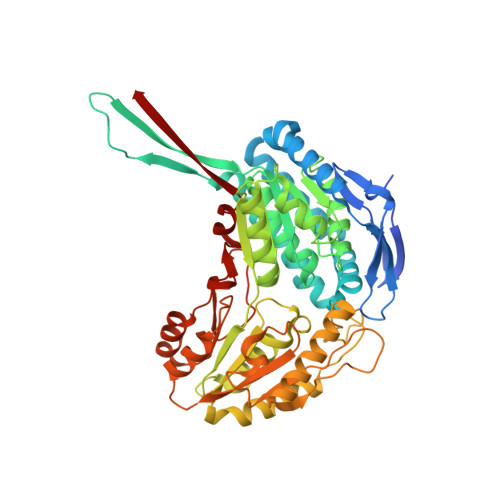Crystal structures of the carboxyl terminal domain of rat 10-formyltetrahydrofolate dehydrogenase: implications for the catalytic mechanism of aldehyde dehydrogenases.
Tsybovsky, Y., Donato, H., Krupenko, N.I., Davies, C., Krupenko, S.A.(2007) Biochemistry 46: 2917-2929
- PubMed: 17302434
- DOI: https://doi.org/10.1021/bi0619573
- Primary Citation of Related Structures:
2O2P, 2O2Q, 2O2R - PubMed Abstract:
10-Formyltetrahydrofolate dehydrogenase (FDH) catalyzes an NADP+-dependent dehydrogenase reaction resulting in conversion of 10-formyltetrahydrofolate to tetrahydrofolate and CO2. This reaction is a result of the concerted action of two catalytic domains of FDH, the amino-terminal hydrolase domain and the carboxyl-terminal aldehyde dehydrogenase domain. In addition to participation in the overall FDH mechanism, the C-terminal domain is capable of NADP+-dependent oxidation of short chain aldehydes to their corresponding acids. We have determined the crystal structure of the C-terminal domain of FDH and its complexes with oxidized and reduced forms of NADP. Compared to other members of the ALDH family, FDH demonstrates a new mode of binding of the 2'-phosphate group of NADP via a water-mediated contact with Gln600 that may contribute to the specificity of the enzyme for NADP over NAD. The structures also suggest how Glu673 can act as a general base in both acylation and deacylation steps of the reaction. In the apo structure, the general base Glu673 is positioned optimally for proton abstraction from the sulfur atom of Cys707. Upon binding of NADP+, the side chain of Glu673 is displaced from the active site by the nicotinamide ring and contacts a chain of highly ordered water molecules that may represent a pathway for translocation of the abstracted proton from Glu673 to the solvent. When reduced, the nicotinamide ring of NADP is displaced from the active site, restoring the contact between Cys707 and Glu673 and allowing the latter to activate the hydrolytic water molecule in deacylation.
Organizational Affiliation:
Department of Biochemistry and Molecular Biology, Medical University of South Carolina, Charleston, South Carolina 29425, USA.


















